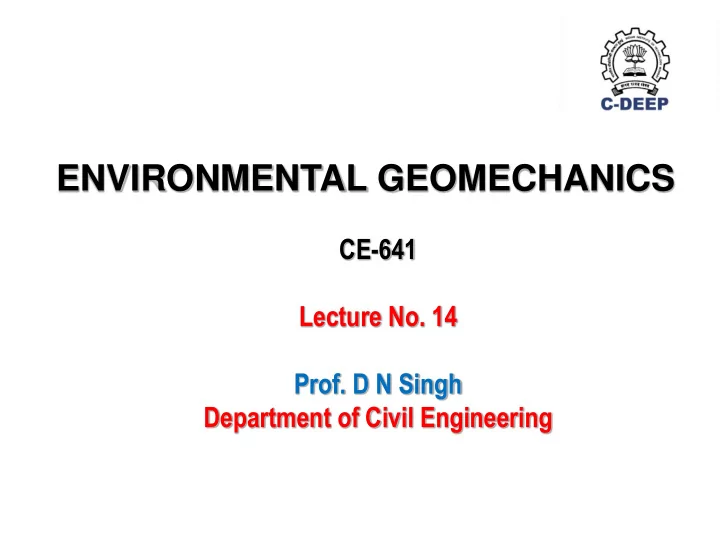

ENVIRONMENTAL GEOMECHANICS CE-641 Lecture No. 14 Prof. D N Singh Department of Civil Engineering
25.09.2019 Lecture No. 14 Lecture Name: Geomaterial Characterization Sub-topics • Chemical characterization Pore-solution sampling Corrosion potential Sorption-Desorption • Thermal Characterization • Electrical Characterization • Magnetic Characterization
CHEMICAL CHARACTERIZATION (In particular for ASSESSMENT OF SOIL CONTAMINATION) Indirect methods Direct methods Impedance spectroscopy Pore-solution extraction (PME) (Impedance analyzer) AAS Electrical resistivity methods ICP-MS Electro-magnetic methods Gas chromatography (TDR/FDR: Time/Frequency domain Ion selective electrodes Reflectometry) Probes/Sensors Dielectric constant PME: Pressure membrane extractor (GPR: Ground penetrating radar) Limitations Expensive instrumentation Cumbersome methodology Intensive & rigorous sample preparation, time consuming Complicated procedure for calibration and analysis Requirement of skilled and trained personnel
Chloride and Sulphite contents determination The chloride and sulphite contents of the soils can be obtained on an extract of 2:1 Liquid to solid ratio. Indion Easy test kit (Ion Exchange, India Ltd.), an ion exchange resin, is employed A sort of a titration Change in color of the solution due to addition of chemicals Soil Salinity Sensors: Used for in situ measurement of soil salinity Soil salinity is an indication of soil contamination
AN INDIRECT METHODOLOGY FOR ASSESSING SOIL CONTAMINATION Exploring the possibility of WP4 (dewpoint potentiameter) Used for measuring soil suction and characterizing unsaturated soil Matric(x) suction (soil matrix) Total Soil Suction Suction Osmotic suction (salts) Soil-water characteristic curve (SWCC) AEV w : water content : Soil suction w w r
Working principle of WP4 Block chamber Works on relative humidity principle Measuring range- 0 to 80 MPa WP4 measures total suction of soil Uncontaminated soil : Total suction = Matric(x) suction Contaminated soil : Total suction = Matric(x) suction + Osmotic suction SWCC of uncontaminated and contaminated soil of same type would be different The difference between SWCCs would indicate soil contamination
A Case study Soil used: Marine soil designated as contaminated soil (CS) Source: Collected from the coastal area of Mumbai, India Physical properties Chemical properties Soil property Value Specific gravity 2.64 Oxide % by weight Particle size characteristics SiO 2 33 Coarse sand (4.75-2.0 mm) 4 Al 2 O 3 11 Medium sand (2.0-0.420 mm) 9 Fe 2 O 3 12 Fine sand (0.420-0.074mm) 11 TiO 2 2 Silt size (0.074-0.002 mm) 44 CaO 6 Clay size (< 0.002 mm) 32 Chlorides (ppm) 9840 Consistency limits Sulphites (ppm) 40 Liquid limit (%) 61 CEC (meq/100g) 4.04 Plastic limit (%) 37 Plasticity index (%) 24 As such the soil is Soil Classification (USCS) MH contaminated
Soil subjected to washing to nullify contamination No. of washings LS Chloride (ppm) Sulphite (ppm) 1 2 6750 15 2 4 1850 10 3 6 800 10 4 8 250 5 5 10 90 < 5 100 1.0 Contaminated soil 90 Washed soil 0.9 80 0.8 70 0.7 60 (ms/cm) 0.6 50 w Difference due to 0.5 contamination 40 0.4 30 0.3 20 Washing nullifies contamination 0.2 10 0.1 0 0.0 0 1 2 3 4 5 6 7 0 1 2 3 4 5 6 7 10 10 10 10 10 10 10 10 No. of washings (kPa)
Recommend
More recommend